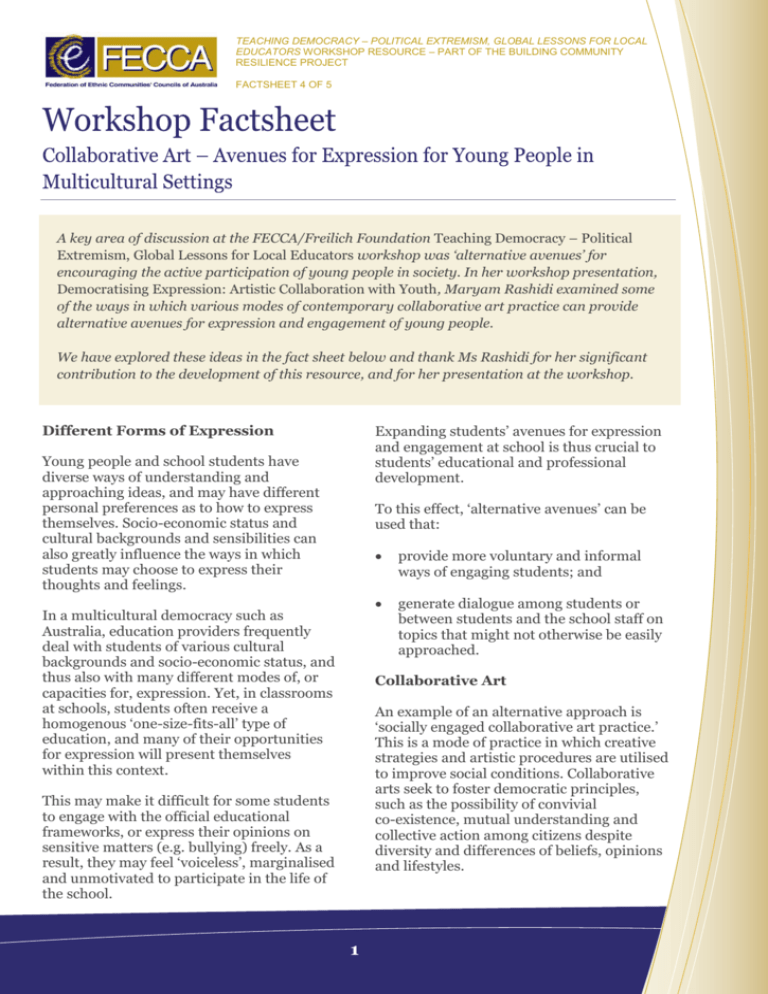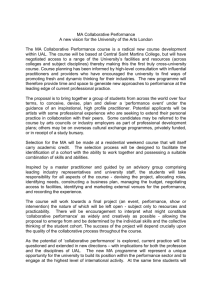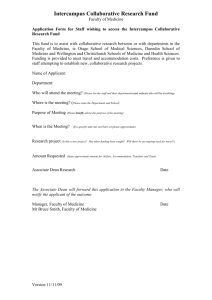Different Forms of Expression
advertisement

TEACHING DEMOCRACY – POLITICAL EXTREMISM, GLOBAL LESSONS FOR LOCAL EDUCATORS WORKSHOP RESOURCE – PART OF THE BUILDING COMMUNITY RESILIENCE PROJECT FACTSHEET 4 OF 5 A key area of discussion at the FECCA/Freilich Foundation Teaching Democracy – Political Extremism, Global Lessons for Local Educators workshop was ‘alternative avenues’ for encouraging the active participation of young people in society. In her workshop presentation, Democratising Expression: Artistic Collaboration with Youth, Maryam Rashidi examined some of the ways in which various modes of contemporary collaborative art practice can provide alternative avenues for expression and engagement of young people. We have explored these ideas in the fact sheet below and thank Ms Rashidi for her significant contribution to the development of this resource, and for her presentation at the workshop. Different Forms of Expression Expanding students’ avenues for expression and engagement at school is thus crucial to students’ educational and professional development. Young people and school students have diverse ways of understanding and approaching ideas, and may have different personal preferences as to how to express themselves. Socio-economic status and cultural backgrounds and sensibilities can also greatly influence the ways in which students may choose to express their thoughts and feelings. To this effect, ‘alternative avenues’ can be used that: In a multicultural democracy such as Australia, education providers frequently deal with students of various cultural backgrounds and socio-economic status, and thus also with many different modes of, or capacities for, expression. Yet, in classrooms at schools, students often receive a homogenous ‘one-size-fits-all’ type of education, and many of their opportunities for expression will present themselves within this context. provide more voluntary and informal ways of engaging students; and generate dialogue among students or between students and the school staff on topics that might not otherwise be easily approached. Collaborative Art An example of an alternative approach is ‘socially engaged collaborative art practice.’ This is a mode of practice in which creative strategies and artistic procedures are utilised to improve social conditions. Collaborative arts seek to foster democratic principles, such as the possibility of convivial co-existence, mutual understanding and collective action among citizens despite diversity and differences of beliefs, opinions and lifestyles. This may make it difficult for some students to engage with the official educational frameworks, or express their opinions on sensitive matters (e.g. bullying) freely. As a result, they may feel ‘voiceless’, marginalised and unmotivated to participate in the life of the school. 1 If conventional modes of art-making involve production of an ‘art object’ (e.g. painting or sculpture) by an individual artist in the isolated space of an artist’s studio, to be viewed by the art-loving public in a gallery or museum, collaborative art practices are instead characterised in the following terms: a co-author of the artistic process and owner of its self-expressions, rather than a passive recipient of some social service, leads to further social inclusion and empowerment of the community. The sites of artistic production and reception shift from the artist’s studio, galleries and museums, to the city, local neighbourhoods or ‘communities’. The ‘community’ may be defined in terms of a marginalised social status or stereotyped identities (such as ethnic or religious affiliations, social class, gender, age, etc.), and thus based on a common need for self-expression. Otherwise, the ‘community’ may be an ad hoc grouping of individuals who work together toward achieving a shared goal. Artistic Collaborations with Youths: A Case Study The following is an example of an artistic collaboration with young people in multicultural settings, and was referred to at the Teaching Democracy Workshop: Rather than the production of ‘art objects’, the ‘art’ in collaborative art practice is conceived as ‘projects’. These projects consist of durational processes of collaboration and exchange between an artist (or group of artists) and members of the above-mentioned communities. While art objects may be used or produced throughout a given project, the main goal of collaborative art practice is to facilitate amicable dialogue and cooperative relationships amongst community members. Collaborative art projects are often initiated with artists receiving invitations or commissions from cultural, educational, or other institutions. The commissions entail that the artist enters a given ‘community’ and establishes a collaborative relationship with community members. This is to collectively identify and, where possible, suggest solutions to issues faced by the community in creative and unconventional ways. The artist thus becomes a facilitator of the creative collaborative process. The collaborative community is considered a ‘co-author’ of the project and gains a strong sense of ownership of its own expressions. Perceiving the community as It is important to remember that the development of collaborative art projects is highly dependent on the social and cultural dynamics of the particular context where the project takes place. Every context is different and artistic strategies adopted in each project must be responsive to contextual circumstances and the particular issues addressed. Singaporean-German artist, Jay Koh, received a three-year commission from an Irish cultural institution (CityArts; 20072010) to develop a project in response to intercultural tensions between the Irish youths and Chinese migrants (mostly university students) in Dublin. The process involved collaborations with a number of cultural institutions in the city, Irish and Chinese youths, and local artists to explore areas of tension. Lack of understanding of each other’s cultural traditions was collectively identified as a major cause of conflict. Koh and other delegates did not offer any concrete solutions to the problem. Rather, their artistic response to the intercultural tension included the organisation of multiple informal educational workshops or guided friendly gatherings over food and karaoke, where the Irish and Chinese youths could speak to each other openly about their cultures and perceptions of each other. An important means of intercultural communication was a photography competition organised for the young Chinese migrants, where they could express their experiences of life in Dublin visually through photographs. Artists and art educators were 2 hired to teach potential participants about principles of photography to prepare them for the competition. All photographs entered in the competition were subsequently exhibited in galleries, cafes and restaurants throughout the city. It will benefit both students and schools to maintain students’ motivation to participate in the life of the school by not always deciding for them and on their behalf, but rather through engaging them directly in the process of decision-making with regards to their needs and preferences. It is, then, important to also acknowledge students’ mutual authorship and ownership of decisions made at the school. Further information on this project can be found at: http://www.cityarts.ie/memory/cityarts/ni haodiaduit.html and http://visualartists.ie/articles/vanmayjune-2010-are-you-a-spy/. The present research shows that what makes collaborative art projects socially ‘effective’ are the relative autonomy, informality, flexibility, and openness of artistic procedures, as well as the freedom inherent in doing things in creative and unconventional ways. It must be noted, however, that the outcomes of these projects will only be sustainable if they are backed up by continued institutional support. More information on Jay Koh’s collaborative art projects in Europe and Asia can be found at: http://www.ifima.net/ifima/personal/jaybi o.htm. Relevance of Collaborative Art for Education and Suggestions Collaborative art practice of the kind presented at Teaching Democracy Workshop can be considered as a key mechanism for exploring and ‘modelling’ various ways of encouraging young people to exercise self-determination and initiative in resolving issues that affect them directly. Perhaps schools can accommodate in their curricula a time and space for students to collaboratively and creatively explore communal needs or existing tensions and experiment with different ways of dealing with them. This may involve hiring artists from outside of the school, who have developed collaborative practices and can engage students in processes that go beyond the school’s everyday official frameworks in order to tackle issues faced by students. In the educational context of a democratic multicultural society like Australia, school students can be treated as ‘collaborative communities’ in the sense that: Further Information Some students may feel marginalised due to their different cultural backgrounds, socio-economic status or other reasons. Others may have difficulty expressing their feelings and opinions about sensitive issues, such as bullying. These students need to be given the opportunity to express themselves and thereby gain a ‘voice’ and a sense of ‘inclusion’ at school. For information about theoretical and philosophical underpinnings of collaborative arts, you can refer to the following two books. These books are among the most widely debated and cited references for artists and theorists alike, and can guide you to other references: School staff may decide to consult and directly engage students for making decisions about matters related to students’ educational performance and wellbeing – e.g. the study curricula, social relationships between students, the furnishing of the classroom, etc. 3 Bourriaud, Nicolas. 2002. Relational Aesthetics. Translated by S. Pleasance, F. Woods and M. Copeland. Dijon: Les Presses du réel. Kester, Grant H. 2004. Conversation Pieces: Community and Communication in Modern Art. Berkley, Los Angeles, London: University of California Press. Written with the assistance of Maryam Rashidi, PhD candidate in Interdisciplinary and Cross-Cultural Studies at the Australian National University (ANU). For further information you can: View the Australian Government’s Multicultural policy at: http://www.immi.gov.au/living-in-australia/a-multicultural-australia/multiculturalpolicy/. View the Multicultural Youth Advocacy Network (MYAN) website at: http://www.myan.org.au/about-us/. This factsheet is one of five resources that FECCA has developed, all of which resulted from a two day workshop Teaching Democracy – Political Extremism, Global Lessons for Local Educators. This workshop was run by the Herbert & Valmae Freilich Foundation at the ANU and FECCA in March 2012. For more information on the workshop, please visit: http://freilich.anu.edu.au/events/teaching-democracy. The workshop and resulting workshop factsheets formed part of a project supported by funding from the Australian Government Attorney-General’s Department under its Building Community Resilience Grants program. A contribution to the project was also made by the School of Humanities and Social Sciences at the University of New South Wales, Canberra. FECCA developed this resource in consultation with the ANU, MYAN, the FECCA Youth Advisory Committee, the teachers and associated professionals who participated in the workshop, and with the Project Steering Committee. For further information on the workshop as a whole, including this resource, please contact the FECCA office on (02) 6282 5755 or at admin@fecca.org.au. 4







